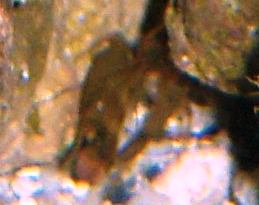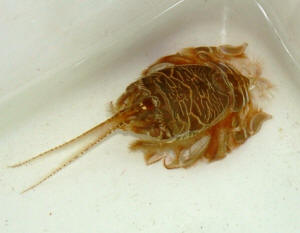|
FAQs about Crustacean Identification
3
Related FAQs: Crustacean
Identification 1, Crustacean ID
2, Crustacean ID 4, &
Crustaceans
1, Crustaceans 2, Crustaceans 3, Crustacean Selection, Crustacean Behavior, Crustacean Compatibility, Crustacean Systems, Crustacean Feeding, Crustacean Disease, Crustacean Reproduction, Micro-Crustaceans, Amphipods, Copepods, Mysids, Hermit
Crabs, Shrimps,
Cleaner
Shrimps, Banded Coral
Shrimp, Mantis
Shrimp, Anemone
Eating Shrimp, Horseshoe
Crabs,
Related Articles: Crustaceans,
Micro-Crustaceans, Amphipods, Copepods, Mysids,
Isopods, Shrimps,
Coral
Banded Shrimp, Cleaner
Shrimp, P. holthuisi Pix,
Mantis
"Shrimp", Lobsters,
Slipper
Lobsters, Hermit
Crabs, Squat Lobsters, Crabs, Arthropods,
Pycnogonids (Sea Spiders),
|
 |
shrimp development stages; ref.
6/25/15
Where can I find a good key to shrimp larval zoea stages? Google has given me no
joy!
Best regards,
Kathy Leahy
<A fave is Text Book of Crustacea by Amita Saxena; but most all invertebrate
textbooks have some coverage. I mainly use Book Finder (.com) to find used
printed works... as they cover/include most other sources. Bob Fenner>
Re: re: shrimp development stages 6/25/15
thanks Bob!
<Welcome Kath. B>
Best regards,
Kathy Leahy
|
Mystery Crustacean: Sand Crab, Albunea sp.
4/10/10
<Hello, Lynn here today. First of all, I sincerely apologize
for the delayed reply. The good news is that I've got an
answer for you!>
I am stumped on this one. Would you please identify this mystery
crustacean for me, please.
<You betcha. It appears to be what's referred to as either
a 'sand' or 'mole' crab although it's not a
true crab/Brachyuran at all. These neat little creatures are
instead Anomurans, a group of Decapod Crustaceans that includes
hermits, porcelain crabs, squat lobsters, etc. Your individual
belongs in the Superfamily: Hippoidea, Family: Albuneidae, Genus:
Albunea. Not a whole lot is known about these 'crabs'
except that they seem to like relatively shallow waters and/or
areas of the swash zone and are able to burrow backwards into the
sand/silt. Of note is that they have the same feathery antennae
and burrowing habits as some of their relatives so they may well
feed on similar foods, in the same manner. For example, in the
family Hippidae, Emerita species are suspension feeders that use
their feathery antennae to filter phytoplankton from the water.
One big difference though, between the genus Emerita and Albunea
that has a bearing on feeding is that Emerita species don't
have any sort of pincers for grasping while Albunea species have
small ('subchelate') ones. Perhaps these animals
filter-feed like Emerita but also grab little items as they pass
by. It's also possible/likely that they do a bit of
scavenging as well. Please see the following links for
comparison. You didn't mention where you found your
individual, or the size, so unfortunately I can't do a lot to
narrow the field of species possibilities for you. Also hindering
the process is a lack of available species photos.
Albunea catharinae, from the S. Atlantic: Note the same finely
serrated edge at the front of the head and the shape of that
outline. It also has the same hairy look about the legs and
front, same antennae (feathery), and same basic anatomy otherwise
(see second row, far right):
http://www.dnr.sc.gov/marine/sertc/gallery.htm
Close-up:
http://www.dnr.sc.gov/marine/sertc/images/photo%20gallery/Albunea.jpg
Albunea marquisiana from the Marquesas: http://decapoda.free.fr/illustration.php?n=2&sp=26
Albunea speciosa from the Society Islands (note the claws):
http://decapoda.free.fr/illustration.php?n=1&sp=27
I hope this information helps! Again, sorry for the delayed
response!>
Thank You
<Take care, LynnZ>
|
 |
|
Strange Creature In Reef Tank...What Is It?
1/21/10
I found a weird creature in my fish tank last night when I was
feeding the fish and corals. This thing measures about 1'
long, it is like a transparent dark brown/green color similar to
a bait shrimp, the head is like in a flat arrow shape, it has
claws that was using to move the crushed seashells from under the
rock, it has pretty long antennas for his size, I'll say
about 1cm, it moves very fast, it will start crawling out very
slow to try to reach some food pellets but I never got to see the
full body out, I saw most of it but never got completely out of
the rock. I used to have an Engineer Goby that dies and I thought
it was a baby but now, this has a mixed look like a
lobster+shrimp+cockroach <?xml:namespace prefix = o ns =
"urn:schemas-microsoft-com:office:office" />
<??>
I managed to take some pictures (attached) but they came a little
blurry and I was only able to get the head , I circled in the
image the creature so you can see it. It moves very fast when
goes back inside the rocks so it took me about 10 minutes to take
the picture.
What is this thing?
<Well, as you say, the pictures aren't resolved enough for
an accurate ID, but by your description, I'm guessing you
likely have a shrimp of some type, possibly a Pistol Shrimp or
Mantis Shrimp. Are you hearing any clicking/snapping
sounds?>
Thank you.
<You're welcome. James (Salty Dog)>
|
 an Alpheid an Alpheid |
Re Strange Creature In Reef Tank...What Is It?
1/21/10
Yes, I do hear some clicking sounds sometimes
<Then you likely have a Pistol Shrimp of some type, but not to
rule out a Mantis Shrimp.
You may want to trap and photograph, and send a couple of pics to
us or ID yourself by Googling. Traps for this purpose are rather
inexpensive and can be had on-line. If it is a Mantis Shrimp,
trouble lies down the road as it grows. For more info on both,
read here.
http://www.wetwebmedia.com/marine/inverts/arthropoda/stomatopods/mantisshrimp.htm
http://www.wetwebmedia.com/pistolshrimps.htm
James (Salty Dog)>
Re Strange Creature In Reef Tank...What Is It? Alpheid
1/21/10
I'll try to take more pictures tonight.
Thanks,
<Sounds good, may want to increase your ASA and use a tripod.
James (Salty Dog)>
Janie
|
|
|

